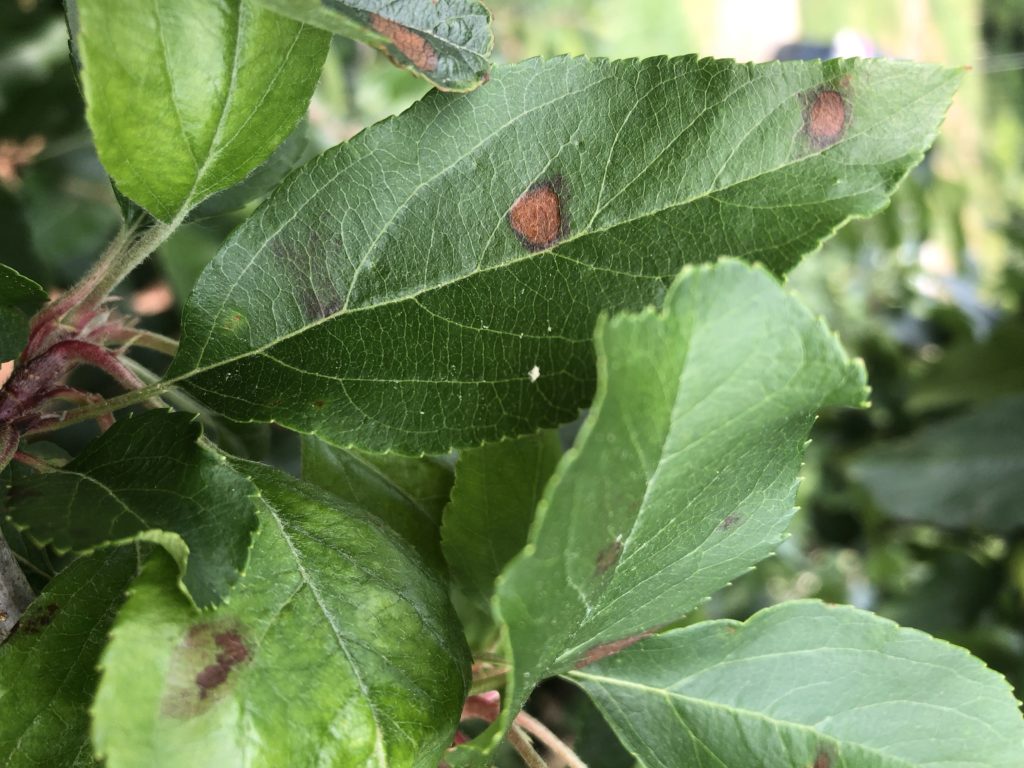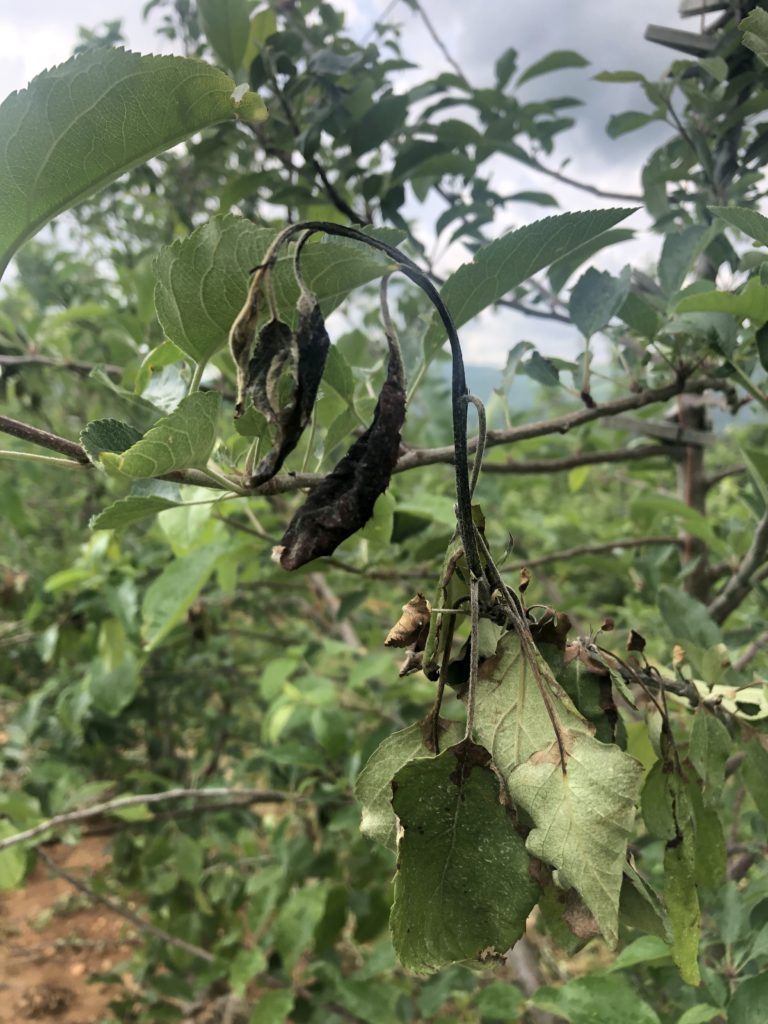2020 Apple Disease Update: PF #2 and 1st Cover
go.ncsu.edu/readext?683096
en Español / em Português
El inglés es el idioma de control de esta página. En la medida en que haya algún conflicto entre la traducción al inglés y la traducción, el inglés prevalece.
Al hacer clic en el enlace de traducción se activa un servicio de traducción gratuito para convertir la página al español. Al igual que con cualquier traducción por Internet, la conversión no es sensible al contexto y puede que no traduzca el texto en su significado original. NC State Extension no garantiza la exactitud del texto traducido. Por favor, tenga en cuenta que algunas aplicaciones y/o servicios pueden no funcionar como se espera cuando se traducen.
Português
Inglês é o idioma de controle desta página. Na medida que haja algum conflito entre o texto original em Inglês e a tradução, o Inglês prevalece.
Ao clicar no link de tradução, um serviço gratuito de tradução será ativado para converter a página para o Português. Como em qualquer tradução pela internet, a conversão não é sensivel ao contexto e pode não ocorrer a tradução para o significado orginal. O serviço de Extensão da Carolina do Norte (NC State Extension) não garante a exatidão do texto traduzido. Por favor, observe que algumas funções ou serviços podem não funcionar como esperado após a tradução.
English
English is the controlling language of this page. To the extent there is any conflict between the English text and the translation, English controls.
Clicking on the translation link activates a free translation service to convert the page to Spanish. As with any Internet translation, the conversion is not context-sensitive and may not translate the text to its original meaning. NC State Extension does not guarantee the accuracy of the translated text. Please note that some applications and/or services may not function as expected when translated.
Collapse ▲I feel like the majority of apple growers in NC would laugh at me and possibly call for my resignation if I told them that getting disease on apple trees really requires a combination of ideal conditions or timing. The pathogen needs to be present and active, the temperature, humidity, and wetting requirements need to be just right, and the host tissue needs to be susceptible to pathogen attack at that time as well. Seems like this should be a fairly rare event..unless you are trying to grow apples in warm and humid regions like NC.
To date, my level of concern about spraying fungicides specifically with Glomerella leaf spot and bitter rot has been fairly low and based on this weeks forecast (which could change at any moment) remains moderately low. HOWEVER… looking at the extended forecast into the first full week of May, the conditions appear ripe for infection by the GLS pathogen, Colletotrichum fructicola. Rain is in the forecast and temperatures during these wetting events may exceed 59 deg. F. Rain should be able to dislodge any mature spores that may be overwintering on leaf debris on the ground and given the predicted warm temperatures during the day and extended leaf wetting hours, infection is likely to occur.
From what I’ve regarding mancozeb and captan in other cropping systems, the first rain after an application usually washes off more fungicide residue than do subsequent rains. Therefore if you make an application of Captan or Mancozeb prior to this Wednesday’s (4/29/20) predicted precipitation and you do not include a fungicide that contains a strobilurin in that tank mix, I would strongly suggest you make another application prior to the predicted rain for next week.
Keep in mind, for resistance management fungicides that contain strobilurins (FRAC 11) should only be applied four times a season. This means that it is not a good idea to spray four applications of Flint Extra, then four applications of Merivon. During the past few years in my program we’ve also been evaluating some of the next generation SDHI (FRAC 7) fungicides for GLS and bitter rot control. Below are results from trials in 2017 and 2019. Timings of SDHI fungicide application are in the chart below-if not listed a captan/ziram or captan/Prophyt cover spray was applied.
 The important take-home messages here are 1) When combined with an EBDC such as mancozeb or ziram, SDHIs provided greater activity than captan + ProPhyt applied from petal fall through harvest (2019); and 2) Efficacy against GLS and bitter rot is not equal for all SDHIs. For take-home point #2, Sercadis (2017) is one of the active ingredients in Merivon. It doesn’t take an advanced degree to see how terribly it performed against bitter rot in 2017. Therefore do not rely on Sercadis (fluxapyroxad) as a tool for resistance management to pyraclostrobin (the other active ingredient in Merivon which does happen to have excellent activity against GLS and bitter rot, but also has a high risk of resistance. Bottom line-If you apply Merivon, mix it with captan, mancozeb, or ziram.
The important take-home messages here are 1) When combined with an EBDC such as mancozeb or ziram, SDHIs provided greater activity than captan + ProPhyt applied from petal fall through harvest (2019); and 2) Efficacy against GLS and bitter rot is not equal for all SDHIs. For take-home point #2, Sercadis (2017) is one of the active ingredients in Merivon. It doesn’t take an advanced degree to see how terribly it performed against bitter rot in 2017. Therefore do not rely on Sercadis (fluxapyroxad) as a tool for resistance management to pyraclostrobin (the other active ingredient in Merivon which does happen to have excellent activity against GLS and bitter rot, but also has a high risk of resistance. Bottom line-If you apply Merivon, mix it with captan, mancozeb, or ziram.
If I were growing commercial apples that were highly susceptible to GLS, AND I did not suspect strobilurin resistance in my orchard, AND I could swing it financially, my suggestion for spraying this week would be:
Sometime between 4/30 and 5/2: Manzate (1/2 rate) + Merivon 5.5 fl oz/A
7 to 10 days later (unless we get a lot of rain and in that case I’ll get a new post out): Aprovia (7 fl oz) OR Fontelis (20 fl oz) + Manzate (1/2 rate)
SHOOT BLIGHT
Just a reminder, that while most of the blossoms are gone it is still shoot blight season. A couple of weeks ago in my petal fall update, I provided some suggestions for management of shoot blight with prohexadione calcium. For those that made that application, my guess is that you are coming up on 14 days since it was applied. Since rain is in the forecast next week and temperatures are predicted to warm, you may want to consider a second application sometime towards the end of this week.
Prediction of shoot blight is tough. If insect vectors are available to move the bacterium and green tissue is emerging, there’s a chance for infection if conducive weather is present. At the 2018 Southeastern Apple Grower’s Meeting Kerik Cox provided some good tips on dealing with fire blight strikes:
- Remove as soon as strikes are noticed on a cool, dry day
- Cut into last season’s growth – at least 12″ into healthy tissue
- For young trees, if 12″ is into the main scaffold remove and replant
- Rescue Program if there are several strikes: Apply Apogee/Kudos 6-12 oz per 100 gallons wait 5 days and then prune every two weeks until terminal bud set.
A word of my own advice-fire blight will kill a young tree, Apogee won’t. Even if an Apogee application delays the growth of a young tree, it’s better to make an application then to watch your tree die a slow and agonizing death.
Young/New orchards/Nurseries: Don’t forget about these trees! Often their phenology/growth stage does not line up to mature trees, particularly if they were just planted this year. Make sure to apply strep during bloom. For other growth stages (including green tip) I suggest make copper applications on a maximum 14 day interval. Use the bloom/low rate of copper so that you don’t burn the leaf tissue. Also, make sure you are regularly checking the trees for phytotoxicity on leaves from the copper and for fire blight strikes!




